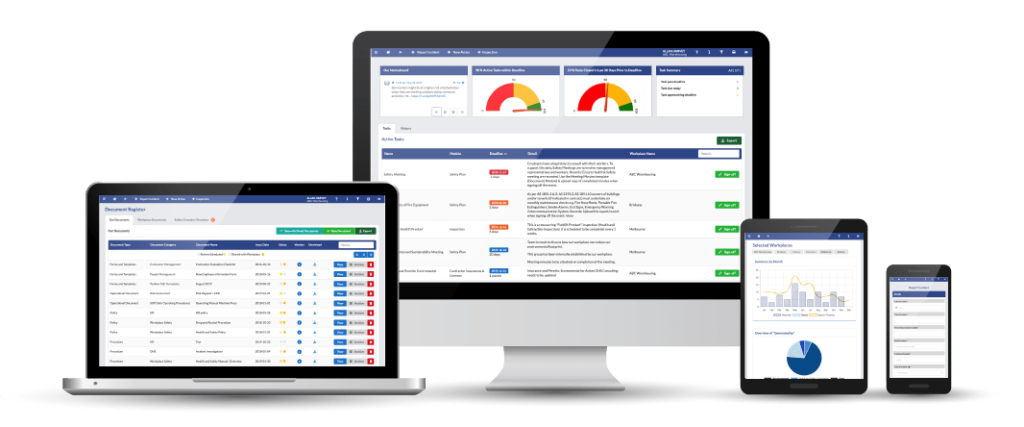© 2025 AusRehab
Our Services
Resources
For Businesses
For Workers
Nov 13, 2024 • 9 min read

Written by: Devanshi Sarda
In today’s dynamic work culture, ergonomics is a powerful investment for employers. Regularly conducting ergonomic assessments can help to prevent injuries, boost productivity and reduce healthcare costs by approximately 72%. By optimising workspaces to meet employees’ needs, businesses can greatly reduce the risk of musculoskeletal disorders (MSDs), which impact approximately 29% of Australia’s population and cost businesses more than $24 billion in 2013.

Safety Champion’s software offers an intuitive platform for managing safety processes, from document storage to real-time monitoring, accessible across all devices. Picture: Safety Champion’s App
Effective documentation is crucial in ergonomic assessments, ensuring that findings and recommendations are accurately recorded and accessible. Utilising tools like Safety Champion’s online safety management system enhances this process by providing a centralised platform for storing and managing assessment records.
This approach not only facilitates compliance with safety regulations but also promotes accountability and continuous improvement in workplace ergonomics. By maintaining detailed records, employers can track the implementation of safety recommendations, monitor their effectiveness, and make informed decisions to optimise employee well-being and productivity.
Discover how Safety Champion can streamline your safety processes
–visit their website today!
60% of employees report experiencing ergonomic-related discomfort in their work environments, including:
According to a 2020 report on the cost of poor-quality (COPQ) work, poor ergonomics produces several consequences for a business, including:
On the other hand, prioritising workplace ergonomics creates several benefits, such as:
Ergonomic equipment refers to tools and furniture specifically designed to support the body’s natural posture and movements, with the primary goal of reducing strain and discomfort. Common examples of ergonomic equipment include:
Ergonomic equipment helps reduce workplace injuries by minimising repetitive movements and promoting long-term postural health. Incorporating ergonomic tools into daily work routines allows employees to adopt positions that align with their natural body mechanics, hence minimising strain on muscles and joints.
With 20% to 60% of office workers affected by musculoskeletal disorders (MSDs) across Australia, the implementation of ergonomic equipment is critical in lowering the risk of work-related musculoskeletal disorders (WMSDs), thereby fostering a safer, more efficient work environment.
The type of ergonomic equipment varies according to job roles, as desk workers and manual labourers face distinct physical challenges.
Desk workers benefit from equipment designed to improve posture and reduce strain from prolonged sitting and repetitive tasks, such as:
Manual labourers, on the other hand, would rely on tools that minimise physical exertion and prevent injuries from heavy lifting, like:
The most effective ergonomic solutions must be tailored to address the specific demands of each role, enhancing both comfort and safety in the workplace.
Employers may leverage several long-term benefits by conducting ergonomic assessments. These perks include:
Significant Reduction in Healthcare Costs:
Increased Employee Productivity
Boost Company Reputation and Employee Engagement:
Ergonomic assessments are an essential step towards cultivating a healthier, safer, and more productive work environment for your employees. At AusRehab, we specialise in providing comprehensive ergonomic assessments tailored to your business needs. Our experts work closely with you to identify and address ergonomic risks, helping you reduce workplace injuries, enhance employee well-being, and boost overall productivity.
Ready to transform your workplace? Contact AusRehab today to schedule your ergonomic assessment and take the first step toward creating a more efficient and engaged workforce.
Want to Make a Change? Share with Anyone, Anywhere.
Don’t forget to share!

Devanshi creates insightful content that highlights best practices in injury management, ergonomic solutions, and strategies to foster safer work environments. Devanshi’s writing aims to inform and support businesses and workers in implementing effective workplace safety measures and rehabilitation practices.
Subscribe to stay updated on the latest workplace news.

Resolve your work
place injury today
Be the first to know about our free training programs, videos, articles, and exclusive offers.

AusRehab acknowledges the Traditional Custodians of Country throughout Australia, recognising their deep ties to land, sea, and community.
We pay our respects to Elders past and present and extend our respect to all Aboriginal and Torres Strait Islander peoples today.
© 2025 AusRehab